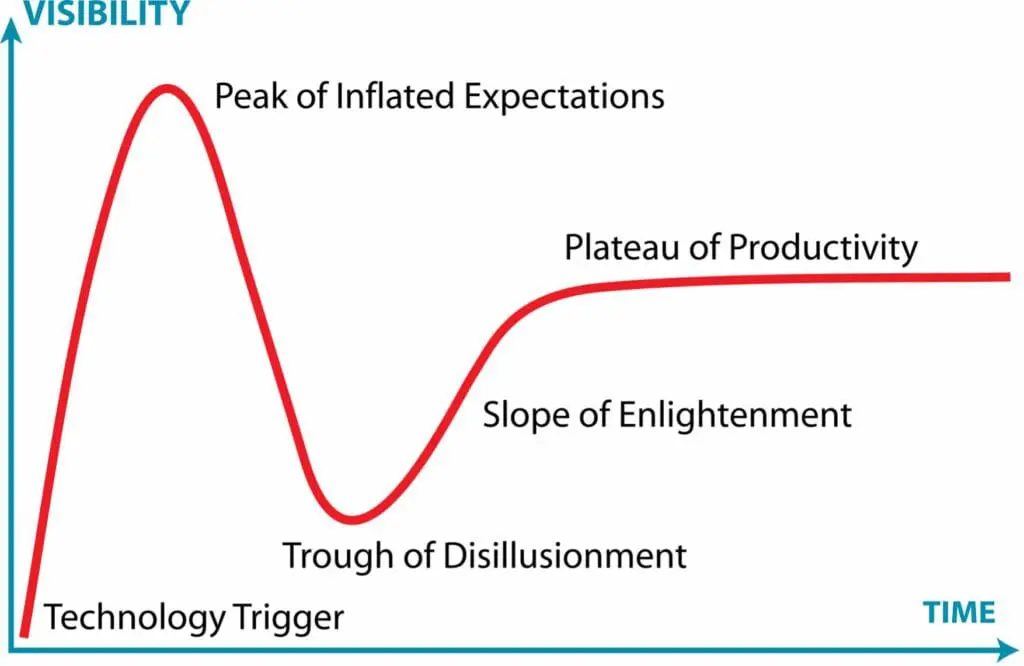The Five Phases of Emerging Technologies
This is a great guest post by Philip Benson, an Emeritus Professor of Orthodontics at the University of Sheffield, UK. He reflects on how we deal with and adopt emerging technologies.
Introduction
SmileDirectClub ceased to trade in December 2023. It was founded in 2014 and at one point was valued at nearly 9 billion dollars*. Before ceasing to trade, SmileDirectClub had an advertisement on their website making claims about their treatment. The advertisement implied that orthodontic treatment time using SmileDirectClub aligners worn for 22 hours a day was between one-fifth to one-third of the time of orthodontic treatment with ‘traditional’ fixed appliance orthodontic treatment.
In my view, the relevant research question to address the accuracy of this advertisement would be.
“In similar patients with similar malocclusions, can overall active orthodontic treatment be completed to a similar standard in a shorter time with a clear aligner compared with a fixed appliance”?
You can see my thoughts about the available, published evidence concerning this research question here: https://osf.io/vfesb
Recent experiences with claims at conferences
While thinking about these claims, I was reminded of the last orthodontic conference I attended. A large proportion of presentations were about orthodontic treatment using clear aligners. Although some treatment results were impressive, and much was spoken about how this technique might promote an orthodontic practice, very little science was presented. At the end of the conference, I was none the wiser about how effective clear aligners were compared with conventional fixed appliance treatment. It also occurred to me that I was sitting in similar conferences ten years ago where a large proportion of presentations were about mini-implants and self-ligating brackets.
Innovation
Innovation, defined as the ‘development of new products, designs, or ideas’ (Cambridge Dictionary), is generally undertaken to improve working practices and, hence, efficiency and productivity, making life easier and more pleasant for humans. Without innovation, we would not have the sophisticated societies we live in today; however, not all innovations are practical and suitable for people or the planet. Many innovations take time to be accepted.
The five phases of adoption of new technologies
The American information technology firm Gartner has produced a graphical representation of five phases during adopting new technologies (https://www.gartner.com), primarily to enable business investment decisions. The vertical axis shows a measure of ‘visibility’ or ‘expectation’ and the horizontal axis time. In the first phase, a new product becomes visible, usually through a small number of early adopters. Early interest rises to a significant peak through anecdotal stories of success; however, as more people use the technique, they encounter problems and become disillusioned. This is followed by a period when solutions are identified, allowing the technique to become more mainstream.

httpscommonswikimediaorgwindexphpcurid=10547051
As far as I am aware, there is no actual scientific research to support the Gartner hype cycle. Furthemore, and I am not mindful of a measure of ‘visibility’ or ‘expectations’. Nevertheless, the graph does reflect my experience of new orthodontic techniques and technologies over 30 years of practising and teaching orthodontics.
As an academic, I am naturally quite cautious about adopting new ideas until I have seen some evidence that it is an improvement over what I am currently doing. We sometimes forget that our patients are not machines. They are biological organisms with different metabolisms, biological reactions, motivations and experiences that will influence treatment outcomes, including treatment time.
I am all for innovation that makes treatment more efficient and pleasant for patients and clinicians, with fewer adverse effects, but if we are to be serious about practising evidence-based orthodontics, then there needs to be research to back them up before they are more widely adopted.
* https://www.nytimes.com/2020/01/21/technology/smiledirectclub-smile-nda.html?action=click&module=RelatedLinks&pgtype=Article (accessed 15 January 2024)

Emeritus Professor of Orthodontics, University of Manchester, UK.
“Hear, hear!”